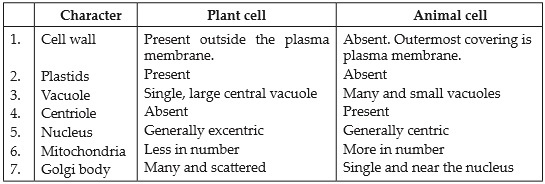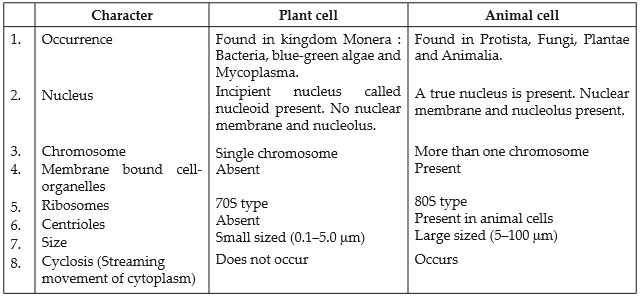Cell-The Fundamental Unit of Life - NCERT - NCERT Questions
Make a comparison and write down ways in which plant cells are different from animal cells
SOLUTION: Differences between plant cells and animal cells are as follows:

How is a prokaryotic cell different from a eukaryotic cell?
SOLUTION: Differences between prokaryotic and eukaryotic cell are as follows:

What would happen if the plasma membrane ruptures or breaks down?
SOLUTION:As the plasma membrane acts as a mechanical barrier to the protoplasm so after the rupturing of plasma membrane, the protoplasmic contents will be dispersed in the surrounding medium.
Q 4.What would happen to the life of a cell if there was no Golgi apparatus?
SOLUTION: In the absence of Golgi apparatus, the following problems will arise:
(i) The secretory activities of the cell will cease to occur.
(ii) The broken membranes like those of lysosomes, cell wall, plasma membrane, etc.will not get repaired.
(iii) Acrosome formation in sperm will not take place, causing inability of sperms to enter the egg.
Which organelle is known as the power house of the cell? Why?
SOLUTION:Mitochondrion is known as the power house of the cell.It is because the mitochondrion is the site of cellular respiration where energy in the form of ATP (adenosine triphosphate) is generated as a consequence of oxidation of food substances.
Q 6.Where do the lipids and proteins constituting the cell membrane get synthesized?
SOLUTION:Smooth endoplasmic reticulum (SER) helps in the manufacture of lipids which are important for cell function.Ribosomes are the sites of protein synthesis.The manufactured proteins are later sent to different places in the cell depending upon the need using the endoplasmic reticulum (ER).
Q 7.How does an Amoeba obtain its food?
SOLUTION:Amoeba acquires its food through endocytosis.Endocytosis refers to invagination of a small region of the plasma membrane and ultimately forming an intra-cellular membrane bound vesicle.This process is generally involved in the ingestion of food material.Intake of liquid food using endocytosis is called pinocytosis or cell drinking.Similarly, intake of solid particles by a cell through its cell membrane is called phagocytosis or cell eating.In this process, cell membrane puts up protoplasmic processes around the food particle.The processes join, fuse to form phagosome.
Q 8.What is osmosis?
SOLUTION:Osmosis involves the passive flow of water or any other solvent from a region of higher water concentration to a region of lower water concentration through a semipermeable membrane.
Q 9.Carry out the following osmosis experiment:
Take four peeled potato halves and scoop each one out to make potato cups. One of these potato cups should be made from a boiled potato. Put each potato cup in a trough containing water. Now.
(a) Keep cup A empty
(b) Put one teaspoon sugar in cup
(c) Put one teaspoon salt in cup
(d) Put one teaspoon sugar in the boiled potato cup
Keep these for two hours. Then observe the four potato cups and answer the following:
(i) Explain why water gathers in the hollowed portion of B and C.
(ii) Why is potato A necessary for this experiment?
(iii) Explain why water does not gather in the hollowed out portions of A and D
(i) Water gathers in B and C because in both the situations there is difference in the concentration of water in the trough and water in the cup (Potato). Hence end osmosis takes place as the potato cells act as a semipermeable membrane.
(ii) Potato cup A is necessary in the experiment as a ‘control’ for providing comparison with situations created in potato cups B, C and D. It indicates that the potato cavity alone does not induce movement of water.
(iii) Water does not gather in hollowed out portions of A and D as cup in A does not have change in concentration of water flow and for osmosis, concentration should be higher than other. In cup D cells are dead, hence semipermeable membrane is not existing for flow of water and no osmosis takes place.